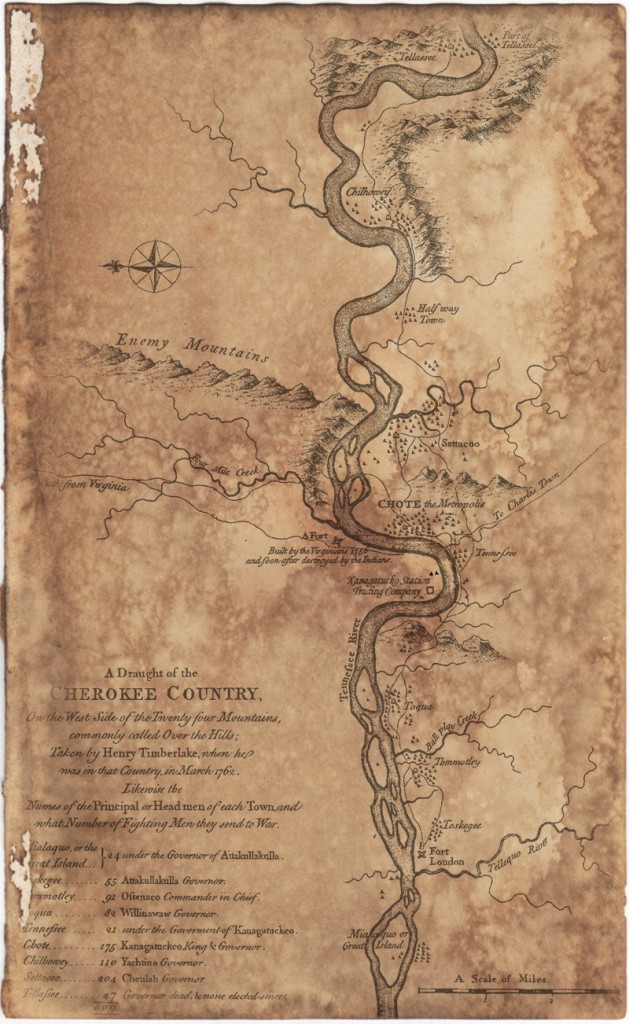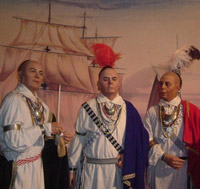 The gentleman shown at the left is Henry Timberlake (1730-1765), an Englishman who, in 1761, travelled into the areas inhabited by the so-called “Overhill” Cherokees—the white men’s name for the Cherokee settlements that were beyond the Appalachian mountains in East Tennessee. Specifically, the area around the English frontier outpost of Fort Loudon.
The gentleman shown at the left is Henry Timberlake (1730-1765), an Englishman who, in 1761, travelled into the areas inhabited by the so-called “Overhill” Cherokees—the white men’s name for the Cherokee settlements that were beyond the Appalachian mountains in East Tennessee. Specifically, the area around the English frontier outpost of Fort Loudon.
Timberlake was a colonial Anglo-American officer, journalist, and cartographer. He was born in Virginia in and died in England. He is best known for his work as an emissary from the British colonies to the Overhill Cherokee during the 1760s.
In 1760, British relations with the Cherokee, which had been moderately friendly for several decades, grew sour after several Cherokee chiefs were imprisoned and killed in South Carolina. In early 1760, the Cherokee laid siege to Fort Loudoun, a remote outpost in what is now Tennessee. The garrison held out until August of that year, but was forced to surrender due to lack of provisions. A relief column under Archibald Montgomerie failed to reach the fort after burning the Cherokee Lower Towns and being stopped at the Battle of Echoee. In spite of the garrison leaving the fort under a flag of truce, the Cherokee killed 22 of its members on their march home in retaliation for the colonists’ earlier killing of 22 Cherokee chiefs held as prisoners at Fort Prince George.
In 1761, Jeffrey Amherst, the British commander in North America, responded with a larger invasion force, sending James Grant against the Middle Towns and sending Byrd to threaten the Overhill towns.
While Byrd proceeded to destroy the Cherokee Middle towns in North Carolina, he dispatched Colonel Adam Stephen into the Holston River valley to attack the Overhill towns. Timberlake accompanied Stephen to Long Island of the Holston (in modern-day Sullivan County, Tennessee), where they began building a base known as “Fort Robinson” and made preparations to march south.
On November 19, 1761, a 400-man Cherokee force led by Chief Kanagatucko (whose name translates as “Standing Turkey”, but was sometimes called “Old Hop”) arrived at the camp and asked for peace, which was immediately granted by Col. Stephen. Kanagatucko asked for an officer to accompany him to the Overhill towns as proof that hostilities had ended. Stephen was reluctant to allow it, but granted the request when Timberlake volunteered. Timberlake was accompanied by then-sergeant Thomas Sumter, an interpreter named John McCormack, and an unnamed servant. The group purchased a canoe and 10 days’ worth of provisions with money Sumter had borrowed. The plan was to follow the Holston River to its confluence with the French Broad River, and then proceed to the Little Tennessee River, where the Overhill towns were situated.
Timberlake’s party left Long Island on November 28, 1761. The Holston River’s unusually low water levels almost immediately stalled the journey, as the party was forced to drag their canoe over exposed shoals and sandbars. The party ran out of provisions after several days, but McCormack managed to shoot a bear, supplying them with several days’ worth of meat. Around December 7, the party explored a stalactite-filled cave situated approximately 50 feet above the river. Timberlake described an incident in which Sumter swam nearly a half-mile in the near-freezing river waters to retrieve their canoe, which had somehow drifted away while they were exploring the cave.
On December 13, the expedition reached a series of treacherous cascades that Timberlake called “Great Falls.” The party spent a whole day carefully maneuvering their way down the cascades only to find the Holston frozen over immediately downstream. The ice slowed the expedition’s progress, but rains on the night of December 14 thawed the ice, and the party passed through the mouth of the Holston (in modern Knoxville) into what is now the Tennessee River on December 15.
Here is the map he drew as a result of the expedition. Note the location of the Kanagatucko Station Trading Company at that time.
Tanasi is the original Cherokee name for what we now call the state of Tennessee. Kanagatucko was a much revered Cherokee warrior and chief. Old Albert was one of his few friends among the white men, and so the trading station was named in honor of the chief. It retains the name and location to this very day.

